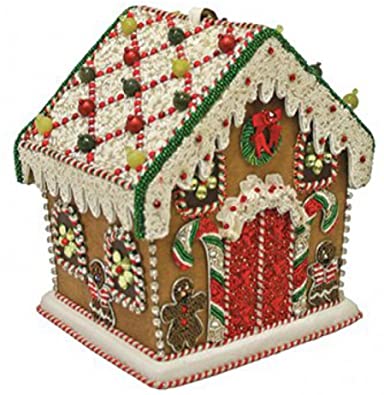Take out all your baking supplies, unleash your imagination and build a gingerbread house on December 12, Gingerbread House Day. Can You Eat This Gingerbread House? Technically, yes, this gingerbread house is edible. But it's made more for decoration then deliciousness. If you're craving gingerbread, make some Gingerbread Cookies, and enjoy them to your heart's delight. Your Gingerbread House Action Plan If you're feeling overwhelmed, break the process down into steps. Here's a suggested timeline. 4 days before: Do the shopping for all ingredients. 3 days before: Make the dough. 2 days before: Print and cut out the pattern pieces (download the templates HERE) 1 day before: Gather all the tools you'll need to make the house: a base for the house, cookie sheets, parchment paper, rolling pin, sharp knife, electric mixer, and a pastry bag with tips (or plastic freezer bag). Day of: Bake your house pieces, assemble, and decorate! (Or add an extra day and bake the house pieces one day and decorate the next.) The Best Candy to Use for a Gingerbread House You can use any candy you want as long as it fits on the house, but if you're looking for suggestions, here are some popular candies, plus a few non-candy items, to decorate a gingerbread house. Gumdrops Round peppermint candies Candy canes Nonpareils M&Ms Hershey's Kisses Regular or mini marshmallows Red licorice twists Evergreen tree and snowman Peeps Sprinkles Shredded coconut (to use as snow) Colored cereal o's How to Make a Gingerbread House PREP TIME: 2 hrs COOK TIME: 15 mins TOTAL TIME: 2 hrs 15 mins SERVINGS: 12 YIELD 1 gingerbread house With 6 cups of flour, how you measure the flour makes a difference. Lightly fluff up the flour in the container, use a cup measure to scoop up flour, then use a blunt knife to level the flour. Do not pack or tamp down the flour in the cup. This recipe is best for making a gingerbread house, not cookies. For cookies, I prefer my gingerbread cookie recipe. If you have pets in your house, keep them away from the gingerbread house during all phases of construction and decorating. Non-gingerbread-house-building-participating adults and children should be informed to keep their hands off the house as well! These instructions were adapted from those found in the 1996 Joy of Cooking. Ingredients Gingerbread House Dough 6 cups (828g) all-purpose flour, plus more for rolling the dough (see recipe note) 1/2 teaspoon baking powder 4 teaspoons ground ginger 4 teaspoons ground cinnamon 1/2 teaspoon ground cloves or allspice 1/2 teaspoon salt 3/4 cup (170g) butter, softened 1 1/2 cups (284g) packed light brown sugar 2 Large Eggs 1 cup dark molasses 1 tablespoon water Royal Icing 2 Large Egg Whites 2 2/3 cups powdered sugar, divided Method Make the Gingerbread Dough Whisk the flour and spices: In a large bowl, whisk together the flour, baking powder, ginger, cinnamon, allspice, and salt. Set aside. Make the butter, sugar, egg, and molasses mixture: Using a stand mixer fitted with the paddle attachment, beat the butter and brown sugar on medium speed until fluffy and well blended. Beat in the eggs, molasses, and water until well combined. Combine the wet and dry ingredients, and knead the dough: Beat half of the flour mixture into the molasses mixture until well blended and smooth. Add in the remaining flour and continue to mix until well blended and a soft cohesive dough forms. Turn the dough out onto a slightly floured work surface and knead by hand 5 or 6 times until the dough is smooth and combined. If dough is too soft, add a little more flour. Divide the dough, wrap and chill it: Divide the dough in half, pat into disks, and wrap each half in plastic wrap. Refrigerate for at least two hours, preferably overnight. You can make it up to 3 days ahead of time. Let sit at room temperature for at least 10 minutes before rolling out.Make the Gingerbread House Pieces Create and cut out the pattern pieces: Create a gingerbread house pattern by cutting out pieces of stiff paper (like that of a manila folder) or cardboard. I like cardboard because it's almost as thick as the gingerbread house pieces will be, and you can create a house model easily using the pieces. Gingerbread House Templates Make sure that you use a ruler and make a templates. Prepare the oven and cookie sheets: Preheat oven to 350°F, with the oven rack in the middle. Have several flat cookie sheets ready, preferably ones that you know will not warp in the oven heat. Roll out the dough: Spread parchment paper on a large flat surface for rolling. Dust the paper lightly with flour. Working with one portion of the dough at a time, use a rolling pin to roll out the dough to an even thickness of 1/4 inch. Add a little flour to the surface of the dough, and check for sticking as you roll it out. If it sticks to either your rolling pin or the rolling surface, dust with more flour. If the rolled out dough is very soft, you may want to freeze it for an hour before cutting out the patterns. Cut out shapes in the dough with pattern pieces: Rub a little flour over the surface of the dough. Place the pattern pieces on the dough, as many pattern pieces as will fit on the dough. Use a small sharp knife to cut out the pattern pieces from the dough, wiping the knife surface clean frequently. Depending on how soft the dough is, you may need to use scissors to cut the parchment paper. You can cut out the patterns through the dough and parchment paper, placing the dough pieces with the paper directly on the cookie sheets. If you are not using parchment paper, you may need to use a large metal spatula to transfer the dough pieces to a greased cookie sheet. Space the pieces on the cookie sheet an inch apart from each other. If dough pieces stretch during the transfer process, push them back into shape. You can cut out a door and window(s) at this point, or you can wait until after baking, soon after the pieces have come out of the oven while the cookies are still warm. Bake: Bake in a 350°F oven until the edges are just beginning to darken, 11-15 minutes for the large pieces, 6 to 8 minutes for the small pieces. Rotate the cookie sheets halfway through the baking for more even browning. Remove the sheets to racks to cool, about 15 minutes. Trim the pieces while warm: While the pieces are still slightly warm, lay the pattern pieces over them and use a large straight chef's knife to trim off any parts of the pieces that have through cooking spread beyond the pattern. Remove pieces to cool directly on racks to cool completely. Make the Royal Icing Make the royal icing: Whisk the egg whites and 1 1/3 cups of the powdered sugar together until smooth . If you are planning to eat your gingerbread house and are concerned about the safety of raw eggs, you can cook the egg white powdered sugar mixture in a double boiler until the mixture reaches a temperature of 160°F, but not higher than 175° (for more information, read How to Pasteurize Eggs at Home). You can also use pasteurized dried or liquid egg whites. Add more powdered sugar, beat to stiff peaks: Add the remaining 1 1/3 cup of powdered sugar to the sugar egg mixture. Using an electric mixer, beat on high speed until the icing holds stiff peaks. If it doesn't form stiff peaks, add more powdered sugar. Place a dampened clean towel over the bowl of royal icing: Keep this towel over the icing to prevent it from drying out while you work with it. Pipe the icing with a pastry bag or cut freezer bag: When you are ready to mortar or decorate, fill a pastry bag with the icing. If you don't have a pastry bag, you can make your own with a re-sealable plastic freezer bag, just cut off the tip (a small cut) of one of the corners of the bag. Plastic or metal piping tips are available in supermarkets which you can also use with a freezer bag, for more controlled piping. Build the House Using Royal Icing as Mortar This is where it really helps to have more than two hands working on a house, and why making a gingerbread house is so much more fun with company than alone. If you are working on this alone, it may help to grab some canned goods from the pantry and use the cans to help prop up the pieces while the icing mortar is drying. Pick and line a base: Pick a solid base for your gingerbread house - either a flat cookie sheet, or a thick, sturdy piece of cardboard. If you want, line the base with aluminum foil or wax paper. Mortar the sides of the house with royal icing: Pipe a thick line of icing along a short end of one of the side pieces. Press the iced side piece against the edge of either the front or back pieces. Hold in place for a few minutes until the icing is partially set. Repeat with the other side piece. Prop up with cans if necessary. Repeat with the other short edges of the side pieces and the remaining front/back piece. Pipe icing along the seams, inside and outside of the house, to fill in any gaps and to add extra stability. Pipe icing along the edges of the house where it meets the base. Let set for at least an hour before attempting to add the roof pieces. If any of the gingerbread house pattern pieces break, as can happen easily when working with what are essentially cookies, most likely you can repair them. On my house I forgot to cut out the door and window until the front piece had almost completely cooled. When I went to make the cuts, the piece broke. Fortunately, it was easy to mortar back together with royal icing. We even created a "splint" out of cardboard and used royal icing to hold the splint to the piece. Let harden completely before using the piece for the house construction. When it comes time to decorate, you can pipe icing right over the broken seam and no one will be the wiser. Mortar in the roof with royal icing: Once the royal icing has dried enough so that the base structure is solid, you can go to work on the roof. Pipe icing all along the top edges of the structure, front and back and two sides. The roof pieces are rectangular-shaped. Place the roof pieces so that the long ends of the rectangle are running along the top of the house. It helps if you have two people working together to place the roof pieces on the house at the same time so that they meet easily at the top center, and extend out a little bit, forming an overhang at each end. Gently hold the roof pieces in place for a few minutes until they are set enough so they don't slide off when you remove your hands. Pipe the top seam of the house with extra icing. Let the house stand for at least an hour, and preferably 8 hours before decorating. Mortar the chimney with royal icing: The dimensions of the chimney can be a bit tricky because of the angle of the roof. Although you may have cut your chimney out of a pattern, these small pieces likely have spread a bit through cooking, and you may have to use a chef's knife to cut the pieces and adjust the angles of the pieces so they align better with the roof. It's easiest to assemble the chimney first upside down, separate from the house. Pipe the pieces together with royal icing and let set until stable. Then, turn the chimney right-side-up and attach it to the roof using piped royal icing. You can do this either right after the house has initially set (1 hour after assembly) or later, during the decorating process. NUTRITION FACTS (PER SERVING) 633 CALORIES 13g FAT 123g CARBS 8g PROTEIN



